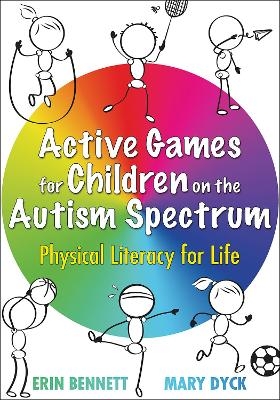
Active Games for Children on the Autism Spectrum
Human Kinetics (Verlag)
978-1-7182-1717-1 (ISBN)
Every school wants to be inclusive. But often children on the autism spectrum are left behind when it comes to participating in physical education and becoming physically literate—in part because many physical educators feel unprepared to include children on the spectrum in class activities.
That’s where Active Games for Children on the Autism Spectrum comes in.
Theoretical Framework, Games, and Lesson Plans
This text provides both the adaptive framework teachers need and more than 80 games to help children on the spectrum take part in physical activity, learn from games, and enjoy being active.
Beyond the framework and games, the book will help physical educators, parents and caregivers, and others develop the courage, competence, and confidence they need to teach and help children on the autism spectrum.
Active Games for Children on the Autism Spectrum offers
an exploration of the ABCs of physical literacy (agility, balance, coordination, and speed);
breakdowns of 16 specific skills, including fundamental movement skills, bike riding, skateboarding or scootering, swimming, and ice skating
22 games to practice the ABCs and skills;
30 single equipment games using Hula-Hoops, bean bags, scarves, rubber balls, gator balls, and racquets and balloons;
29 lesson plans for target games, net and wall games, striking and fielding games, and invasion games using the Teaching Games for Understanding approach;
21 bonus games to practice what is learned in the lessons;
14 warm-up and sport skill games;
4 warm-up games to be used in an inclusive class; and
1 sample home or gym fitness program.
Games Are Easy to Use and Purposeful
The games are easy to use, with clear instruction on how to effectively teach movement skills to all students, including those on the spectrum. The games are active, enjoyable, and imbued with purpose. They are accessible to anyone working with children on the autism spectrum in school, at home, or in other settings.
What Sets This Book Apart
What sets this text apart from similar books is its wealth of theoretical and practical content beyond the games. Its focus on physical activity, wellness, health, inclusion, and physical literacy in a wide variety of environments, along with its foundational content, makes Active Games for Children on the Autism Spectrum highly valuable to both experienced and inexperienced teachers, as well as parents and others working with children with autism. Chapters on physical literacy, adapting physical activity, planning, movement skills, community, family and friends, and fitness create a well-rounded, thorough exploration of how to help children on the spectrum enjoy the benefits of physical education and an active lifestyle. In doing so, these children can enhance their health, improve their motor skills, and strengthen their social skills.
Erin Bennett is the owner of APAC Lethbridge, which provides adapted physical activity programs for children, youths, and adults of all ability levels in the Lethbridge community. Erin also provides specialized adapted physical education programs for students in the Lethbridge public school district. Erin, a recipient of an Erasmus Mundus scholarship, received a master’s degree in adapted physical activity from the Katholieke Universiteit–Leuven in Belgium and completed her bachelor’s degree in physical education from the University of Alberta. At the University of Alberta Erin worked at the Steadward Centre, which is a specialized center for adapted physical activity founded by Dr. Robert Steadward. Mary Dyck, PhD, is a retired kinesiology instructor from the University of Lethbridge in Alberta, Canada. She taught adapted physical activity for 10 years. During that time, Mary expanded community adapted activity programs as program codirector for Soccability and manager for the Lethbridge wheelchair basketball program. She was the manager for the Canadian deaf indoor volleyball and beach volleyball program that competed at the Deaflympics from 2015 to 2023. She was inducted into the Lethbridge Sports Hall of Fame as a Builder in 2020. She has coauthored two books—Everybody Move and Coaching Volleyball Champions: Principles and Practices of Successful Coaches. Mary has 30 years of experience coaching children, coaching athletes in university and provincial programs, and facilitating coaching clinics in volleyball and soccer.
Chapter 1. Introduction
Understanding Physical Literacy
On the Autism Spectrum
Characteristics of Children and Considerations for Physical Literacy and Games
A Word About Language
Conclusion
Chapter 2. Adapting Physical Activity
Selecting the Best Environment for Developing Physical Literacy
ADAPT Decisions
Task Progressions
Adapting With Equipment
Conclusion
Chapter 3. Planning
Communication
Planning for the Learning Environment
Planning for Teaching Physical Literacy and Games
Motivation
Sense of Control
Conclusion
Chapter 4. Fundamental Movement Skills
ABCs of Physical Literacy
Teaching Fundamental Movement Skills
Single Equipment Teaching Method
Ball Sense
Go-To Games
Recess and Playground
Conclusion
Chapter 5. Physical Education and Community
Planning for Physical Education
Transitioning Activities From One-on-One to Inclusive Group
Teaching Games for Understanding (TGfU)
TGfU Lessons
Warm-Up and Sport Skill Games
Inclusive Community Sports Program: Soccability
Conclusion
Chapter 6. Family and Friends
Bike Riding
Skateboarding (Scooter)
Swimming and Water Safety
Ice Skating
Conclusion
Chapter 7. Fitness
Fitness In and Outside of School
Instructional Considerations and Tools
Questions to Ask
Activities
Conclusion
| Erscheinungsdatum | 22.08.2023 |
|---|---|
| Verlagsort | Champaign, IL |
| Sprache | englisch |
| Maße | 178 x 254 mm |
| Gewicht | 408 g |
| Themenwelt | Sozialwissenschaften ► Pädagogik ► Schulpädagogik / Grundschule |
| Sozialwissenschaften ► Pädagogik ► Sonder-, Heil- und Förderpädagogik | |
| Weitere Fachgebiete ► Sportwissenschaft | |
| ISBN-10 | 1-7182-1717-X / 171821717X |
| ISBN-13 | 978-1-7182-1717-1 / 9781718217171 |
| Zustand | Neuware |
| Informationen gemäß Produktsicherheitsverordnung (GPSR) | |
| Haben Sie eine Frage zum Produkt? |
aus dem Bereich


